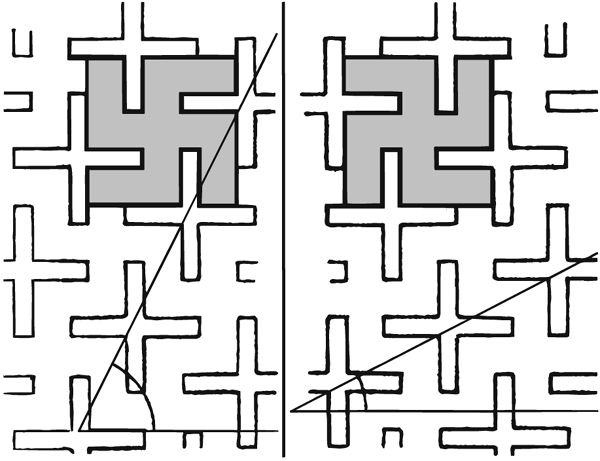|
 |
|
|
Crosses Watermarks: Normal at left ..... Mirror Image at right
(viewed from the reverse) |
|
| |
There are three methods for determining normal vs mirror image.
1) Angle of a line drawn through the center of the lower left intersection points of the crosses, illustrated above.
2) Clockwise (normal) or counter-clockwise (mirror image) direction of the swastika arms formed by the unwatermarked areas between the crosses, illustrated above.
3) Position of any particular point/end of a cross member relative to the cross next to it. For example, the top tip of a cross is either to the right-center of the cross to the left of it (normal), or to the bottom right of the cross to the left of it (mirror image). |
|
|
|
| Denmark, Iceland, and DWI: Normal and Mirror Image Crosses Watermarks |
|
by Jay Smith
[This article presents information and an illustration from the AFA Iceland Specialized Catalog 1997 of which I was the translator and principal editor of the English edition. There has been no subsequent edition of that useful catalog and due to a change in the ownership of AFA, no new edition is likely. This catalog is still in-print and available, here.]
The stamps printed in Denmark (which includes Icelandic stamps of the era and Danish West Indies stamps) starting in 1913 and running through 1932 (some through 1934 for Iceland) utilized paper with a repeating crosses watermark. Prior to that, crown watermarks had been used since the first issues.
A normal "inverted" watermark, such as that of a crown watermark, results from the stamp paper being turned 180 degrees (upside down). The "mirror image" watermark, pictured above on the right, results from the paper being turned over -- printed on the backside. The crosses watermark has identical appearance when the paper is upright or inverted, but appears differently when the paper is turned over.
The Danish term used in the specialized catalogs for the mirror image watermark is "spejlvendt vm".
I am aware of three methods for identifying the two watermark positions:
1) Angle of a line drawn through the center of the lower left intersection points of the crosses, illustrated above.
2) Clockwise (normal) or counter-clockwise (mirror image) direction of the swastika arms formed by the unwatermarked areas between the crosses, illustrated above.
3) Postion of any particular point/end of a cross member relative to the cross next to it. For example, the top tip of a cross is either to the right-center of the cross to the left of it (normal), or to the bottom right of the cross to the left of it (mirror image). This is the method that I find most useful especially when the watermark is hard to see or the stamp design or postmark interferes with viewing. You only need to know for sure what location on a cross you are looking at and then the location relative to the nearest adjacent cross. You do not have to actually see the whole cross(es).
For Iceland, only the AFA Iceland Specialized Catalog 1997 lists the two types. This is the only (and still very useful) edition of this catalog.
For Denmark & DWI, only the AFA Specialkatalog (AFA Specialized Catalog for Denmark, Faroe, Greenland, Danish West Indies, and Slesvig; issued every 5-6 years. The most recent edition is 2008.)
The catalog values shown in the AFA catalogs always show a higher value for the mirror image watermark (spejlvendt vm), however, the difference is almost always very modest. In my opinion, the value differences appear to be arbitrary rather than the result in-depth sales price analysis. (Sellers tend to price based on the catalog value and the catalog editors say they refer to sellers' prices, thus in a circle it goes.) The reality probably is that not many collectors get excited about a watermark difference that is not very obvious (it's not like an inverted crown which is very easy to see and understand), thus they don't send want lists to dealers. Dealers thus don't get a sense of what is and is not in strong demand. Perhaps if the catalogs stated that the stamps were "printed on the wrong side of the paper" there would be more demand? The reality is that, whether normal or mirror image watermark, dealers' selling price have to take into account the work (and inhalation of watermark fluid fumes) of sorting out the watermarks -- it takes much longer than a typical normal vs inverted watermark situation.
Some stamps must be much scarcer than others with one or the other type of watermark. In the case of Iceland (where I have paid more attention), I have not yet noticed any that are "rare" one way or the other, but my data sample is quite small. I would be interested in knowing of any in-depth work that has been done on this subject.
Up to this time, I have not specifically kept my stock sorted or offered them separately in price lists, but I have always welcomed want lists from those seeking the normal vs mirror image watermarks. Want lists are welcome at email: js@JaySmith.com
|

